Unit 11: Equity, Diversity, and Inclusion: Terminology
Learning Objectives
 After reviewing this information, you will be able to
After reviewing this information, you will be able to
-
-
- Define personal, social, and cultural identities
- Explain why difference matters in the study of culture and identity
- Understand important areas of intercultural communication
- Understand equity, diversity, and inclusion terminology
-
Introduction
Humans have always been diverse in their cultural beliefs and practices. But as new technologies have led to the perception that our world has shrunk, and demographic and political changes have brought attention to cultural differences, people communicate across cultures more now than ever before. The oceans and continents that separate us can now be traversed instantly with an e-mail, phone call, tweet, or status update. Today, our workplaces are more integrated in terms of race, sexuality, age, physical and mental ability, and gender, increasing our interaction with domestic diversity. The Disability Rights Movement and Gay Rights Movement have increased the visibility of people with disabilities and sexual minorities. But just because we are exposed to more difference doesn’t mean we understand it, can communicate across it, or appreciate it. This chapter will help you do all three by providing the terminology required to better understand and communicate issues of equity, diversity, and inclusion (EDI). Let’s begin the process with the video: What Do Equality, Diversity, Equity and Inclusion Mean (2021).
It’s important to understand how EDI and communication relate. Discussing these issues is difficult for many reasons. One is due to uncertainty about language use. People may be frustrated by their perception that labels change too often or be afraid of using an “improper” term and being viewed as insensitive. It is important, however, that we not let political correctness get in the way of meaningful dialogues and learning opportunities related to difference. Exploring some of these very difficult issues can make us more competent communicators and open us up to more learning experiences.
Defining Identity
Ask yourself the question “Who am I?” Our parents, friends, teachers, and the media help shape our identities. While this happens from birth, most people reach a stage where increased social awareness led them to begin to reflect on who they are. This begins a lifelong process of thinking about who we are now, who we were before, and who we will become (Tatum, 2000). Our identities make up an important part of our self-concept and can be broken down into three main categories: personal, social, and cultural identities (see Table 11.1).
Table 11.1 Personal, Social, and Cultural Identity
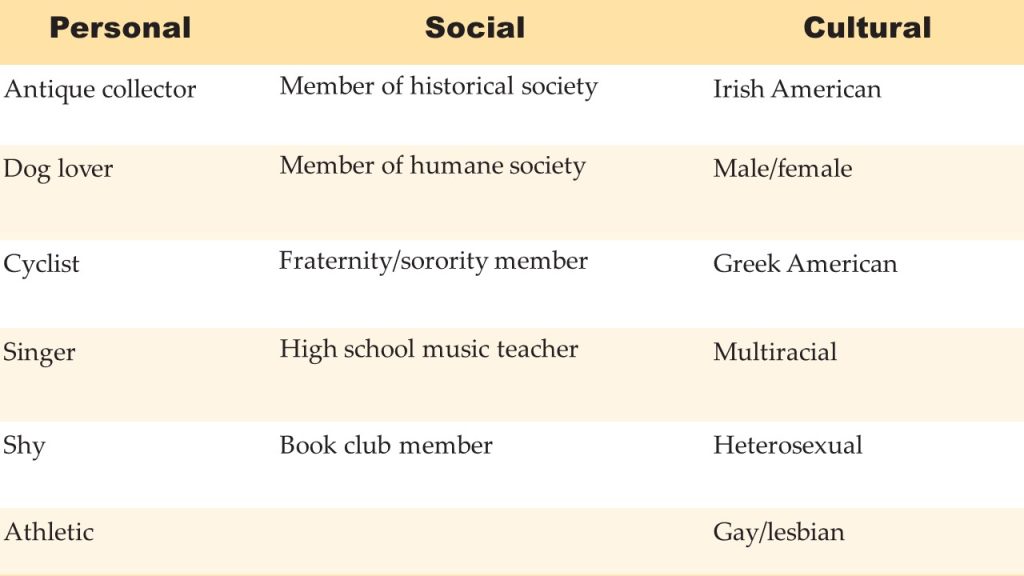
Personal identities include the components of self that are primarily intrapersonal and connected to our life experiences. For example, some people may consider themselves puzzle lovers, while others may identify as fans of hip-hop music.
Our social identities include components that come derived from our involvement in social groups. For example, we may get aspects of our social identity from our family or from a sports team we are part of. Social identities differ from personal identities because they are externally organized through membership. Our membership may be voluntary (Greek organization on campus) or involuntary (family) and explicit (we pay dues to our labour union) or implicit (we purchase and listen to hip-hop music). There are many options for personal and social identities. While our personal identity choices express who we are, our social identities align us with particular groups. Through our social identities, we make statements about who we are and who we are not.
Cultural identities are based on categories developed by society that teach us how to behave (Yep, 2002). Since our cultural identities are a part of us since birth, cultural identities are the least changeable of the three identities. Our cultural identities can change over time, but what separates this category from the other two categories is their historical roots (Collier, 1996).
Dominant and Non-dominant identities have been established by social and cultural influences (Allen, 2011). Dominant identities historically had and currently have more resources and influence, while non-dominant identities historically had and currently have fewer resources and influence. It’s important to remember that these distinctions are being made at the societal level, not the individual level. There are obviously exceptions, with people in groups considered non-dominant obtaining more resources and power than a person in a dominant group. However, the overall trend is that difference based on cultural groups has been institutionalized, and exceptions do not change this fact.
Because of this uneven distribution of resources and power, members of dominant groups are granted privileges while non-dominant groups are at a disadvantage. This means non-dominant groups will face various forms of institutionalized discrimination, including racism, sexism, heterosexism, and ableism. As we will discuss later, privilege and disadvantage are not “all or nothing.” No two people are completely different or completely similar, and no one person is completely privileged or completely disadvantaged.
Cultural Identities
Culture is a complicated word to define, as there are many ways that the term culture is commonly used. For the purposes of exploring the communicative aspects of culture, we will define culture as the ongoing negotiation of learned and patterned beliefs, attitudes, values, and behaviours. The definition points out that culture is learned. Culture is also patterned in that there are recognizable widespread similarities among people within a cultural group. There is also deviation from and resistance to those patterns by individuals and subgroups within a culture, which is why cultural patterns change over time. Last, the definition acknowledges that culture influences our beliefs about what is true and false, our attitudes including our likes and dislikes, our values regarding what is right and wrong, and our behaviours. Some categories of culture are explored below.
Race
Race is a socially constructed category based on differences in appearance that have been used to create a social order that gives privilege to some and disadvantage to others. Race didn’t become a socially and culturally recognized marker until European colonial expansion in the 1500s. As Western Europeans travelled to parts of the world previously unknown to them and encountered people who were different from them, a classification of races began to develop that placed lighter skinned Europeans above darker skinned people. Racial distinctions have been based largely on features such as skin colour, hair texture, and body/facial features. Even though there is a consensus among experts that race is social rather than biological, we can’t deny that race still has meaning in our society and affects people as if it were “real.”
The way we communicate about race in our regular interactions has also changed, and many people are still hesitant to discuss race for fear of using “the wrong” vocabulary. Given that race is one of the first things we notice about someone, it’s important to explore how race and communication are connected (Allen, 2011).
Race and communication are related in various ways. Racism influences our communication about race and is not an easy topic for most people to discuss. Today, people tend to view racism as overt acts such as calling someone a derogatory name or discriminating against someone in thought or action. However, there is a difference between racist acts and other discriminatory behaviours that are much more subtle. As competent communicators and critical thinkers, we must challenge ourselves to be aware of how racism influences our communication at individual and societal levels. Figure 11.1 presents a recent census on racial make-up confirming Canada’s diversity and the need to develop inter-cultural communication competency.
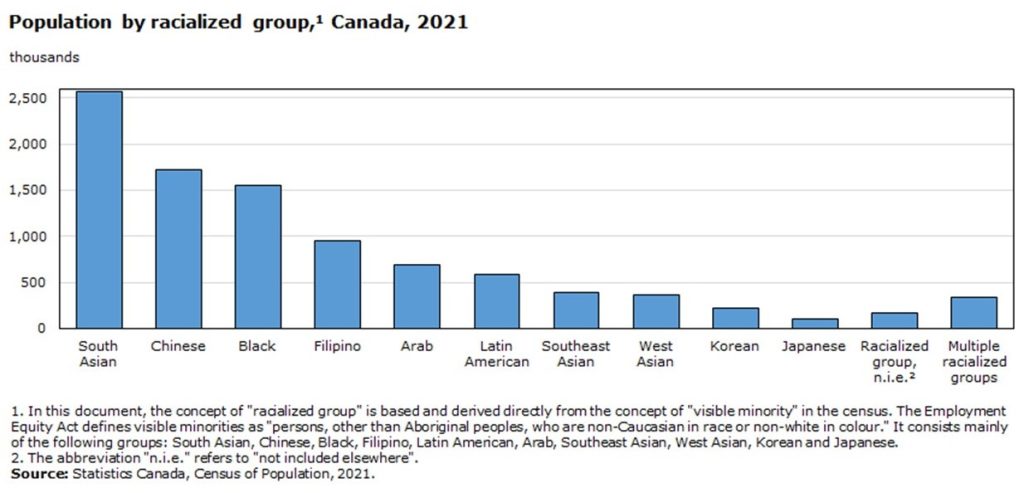
Gender
When we first meet a newborn baby, we ask whether it’s a boy or a girl. This question illustrates the importance of gender in organizing our social lives and our interpersonal relationships. While it is true that there are biological differences between who we label male and female, the meaning our society places on those differences is what actually matters in our day-to-day lives.
You may have noticed the word gender instead of sex is being used. That’s because gender is an identity based on internalized cultural notions of masculinity and femininity that is constructed through communication and interaction. However, sex is based on biological characteristics, including external genitalia, internal sex organs, chromosomes, and hormones (Wood, 2005). A related concept, gender roles, refers to a society’s expectations of people’s behaviour and attitudes based on whether they are females or males. Understood in this way, gender, like race, is a social construction.
Sexuality
While race and gender are two of the first things we notice about others, sexuality is often something we view as personal and private. Sexuality relates to culture and identity in important ways that extend beyond sexual orientation, just as race is more than the colour of one’s skin and gender is more than one’s biological and physiological manifestations of masculinity and femininity.
The most obvious way sexuality relates to identity is through sexual orientation. Sexual orientation refers to a person’s primary physical and emotional sexual attraction and activity. The terms we most often use to categorize sexual orientation are heterosexual, gay, lesbian, bisexual, and asexual. Gays, lesbians, and bisexuals are sometimes referred to as sexual minorities.
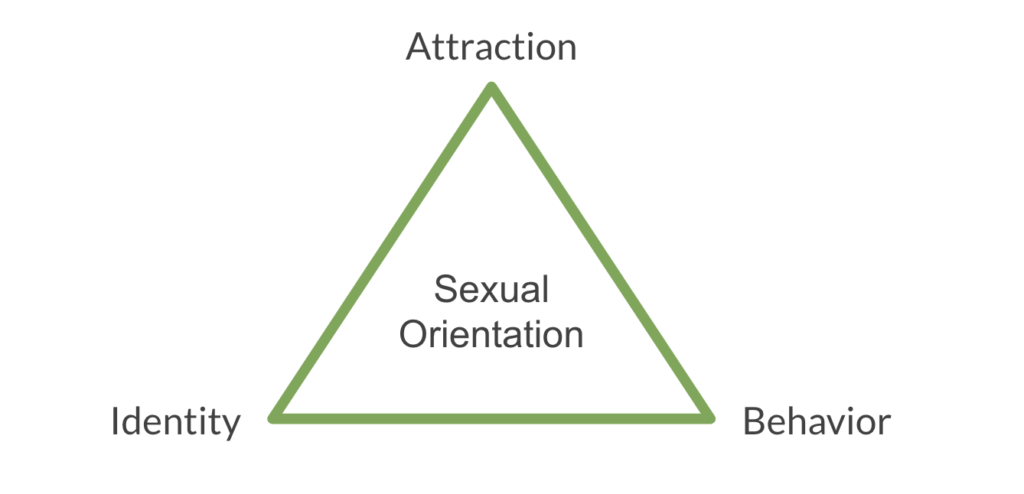
Homophobia is a range of negative attitudes and feelings towards homosexuality or people perceived as homosexual. Homophobia is observable in critical and hostile behaviour like discrimination and violence. Much like racism or sexism, homophobia involves the targeting of a specific population of individuals with certain traits. Homophobia, or the fear of lesbian, gay, bisexual, transgender, and queer (LGBTQ) individuals, is often the impetus for discrimination, which can be expressed through either institutional or informal means (“Homophobia”, 2020).
Thus, cultivating the awareness to recognize and address institutional and informal means of discrimination based on sex, gender, sexuality, and sexual orientation are important aspect of developing communication competence.

Ability
There is resistance to classifying ability as a cultural identity. While much of what distinguishes physically and mentally abled persons from physically and mentally disabled persons is rooted in science, biology, and physiology, there are important sociocultural dimensions. The Accessible Canada Act defines disability as “any impairment, including a physical, mental, intellectual, cognitive, learning, communication or sensory impairment — or a functional limitation — whether permanent, temporary or episodic in nature, or evident or not, that, in interaction with a barrier, hinders a person’s full and equal participation in society” (Minister of Justice, 2023). An impairment is defined as “any temporary or permanent loss or abnormality of a body structure or function, whether physiological or psychological” (Allen, 2011). These definitions are important because they note the social aspect of disability in that people’s life activities are limited. In addition, the definitions also suggest the social aspect of disability because the perception of a disability by others can lead someone to be classified as such. Ability, just as the other cultural identities discussed, has institutionalized privileges and disadvantages associated with it.
Ableism is the system of beliefs and practices that produces a physical and mental standard that is projected as normal for a human being and labels deviations from it abnormal, resulting in unequal treatment and access to resources. Ability privilege refers to the unearned advantages that are provided for people who fit the cognitive and physical norms (Allen, 2011). According to Figure 11.3, “in 2022, 27% of Canadians aged 15 and older, or 8 million people, had at least one disability” (StatsCan, 2023). Canadians living with a disability make up a large portion of our society. Thus, as society slowly begins to accommodate Canadians with disabilities, there is a need for inter-ability communication competence. Inter-ability communication is communication between people with differing ability levels; for example, a hearing person communicating with someone who is hearing impaired or a person who doesn’t use a wheelchair communicating with someone who uses a wheelchair.
EDI Terminology
As stated a little earlier in this chapter, conversations around EDI can be difficult, even scary, for many because no-one wants to say the wrong thing or to offend someone else. In this section, you will find a few terms that will be used throughout our discussion of EDI in this textbook; terms, that once learned, you can use to have meaningful conversations about EDI.
Microaggression
According to Kevin Nadal (2014), microaggressions are brief and commonplace daily verbal, behavioural, or environmental actions (whether intentional or unintentional) that communicate hostile, derogatory, or negative racial slights and insults toward members of oppressed or targeted groups including: people of colour, women, Lesbian, Gay, Bisexual and Transgender (LGBT) persons, persons with disabilities, and religious minorities. Some scholars today argue that racism, sexism, homophobia, and other forms of discrimination are no longer as blatant as they may have been in the past. Instead, people may demonstrate their biases and prejudices in more subtle ways, otherwise known as microaggressions.
Microaggressions, as the following video, What is the Definition of Microaggression (2023), explains are not harmless. According to Nadal (2014), members of marginalized groups that experience microaggressions experience depression, anxiety, and trauma.
Intersectionality
The privileges-disadvantages conflict captures the complex interrelation of unearned, systemic advantages and disadvantages that operate among our various identities. As was discussed earlier, our society consists of dominant and nondominant groups. Accordingly, different cultures and identities have certain privileges and/or disadvantages.
To understand this interaction, we must view culture and identity through a lens of intersectionality, which asks us to acknowledge that we each have multiple cultures and identities that intersect with each other. Because our identities are complex, no one is completely privileged and no one is completely disadvantaged. For example, while we may think of a White, heterosexual male as being very privileged, he may also have a disability that leaves him without the able-bodied privilege that an abled body Latina woman has.
which asks us to acknowledge that we each have multiple cultures and identities that intersect with each other. Because our identities are complex, no one is completely privileged and no one is completely disadvantaged. For example, while we may think of a White, heterosexual male as being very privileged, he may also have a disability that leaves him without the able-bodied privilege that an abled body Latina woman has.
This is often a difficult discussion for students to understand, because they are quick to point out exceptions that challenge this notion. For example, many people like to point out global media personality Oprah Winfrey as a powerful African American woman. While she is definitely now quite privileged despite her disadvantaged identities (black, woman, and born poor), her trajectory isn’t the norm. When we view privilege and disadvantage at the cultural level, we cannot let individual exceptions distract from the systemic and institutionalized ways in which some people in our society are disadvantaged while others are privileged.
Systemic Racism
Today, people tend to view acts of exclusion and discrimination as overt acts such as calling someone a derogatory name or discriminating against someone in thought or action. However, there is a difference between these types of individual acts, and systemic racism. Systemic racism is not as easily identifiable and is not attached to a person or a singular act. Instead, systemic racism occurs through patterns, practices, behaviours and ways of being established in societal institutions, laws, and policies that favour some and disadvantage others. Thus, racism, discrimination, and acts of exclusion exists and occur daily that are not committed by any one person but occur via the practices, policies, laws, and culture that exists in our societal institutions. Figure 11.4 illustrates some of the societal institutions where systemic racism exists.
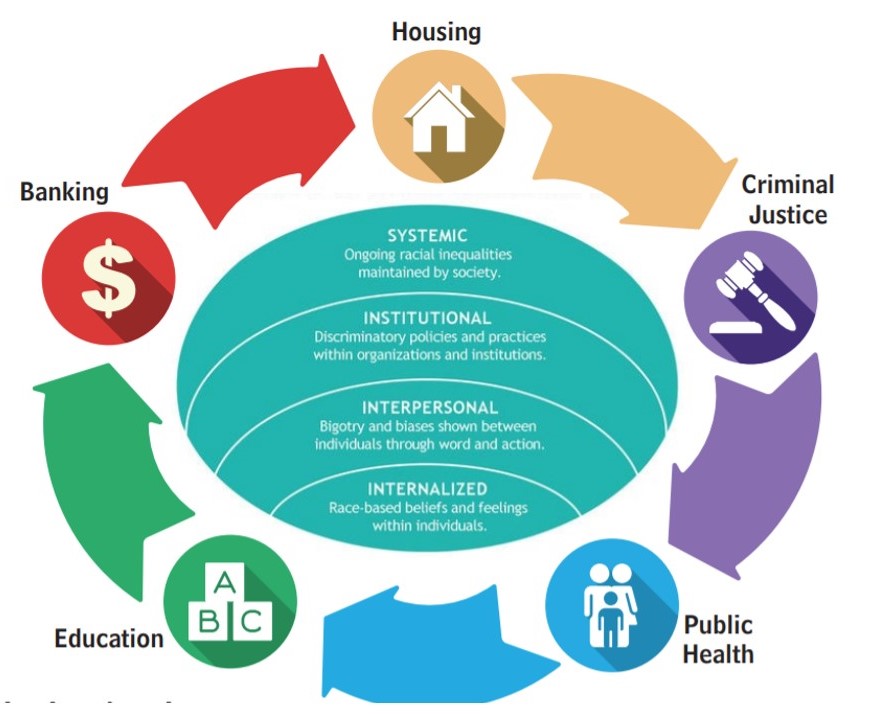
Unconscious Bias
Today, there is a greater appreciation of the fact that not all biases are overt hostility based on a personal animosity toward members of a group. Unconscious bias (also called “automatic” or “implicit” biases) are unexamined and sometimes subtle behaviours and/or thoughts, but are just as real in their consequences and impacts. An unconscious bias can be considered automatic, ambiguous, and ambivalent, but it is nonetheless biased, unfair, and disrespectful to a belief in equality.
 Most people have a positive view of themselves. They believe they have good values, rational thoughts, and strengths. Most people also identify as members of certain groups but not others. They are Canadian, or fans of Manchester United, or are doctors. Logic suggests, then, that because we like ourselves, we also like the groups in which we are members. We might feel affinity toward people from our home town, a connection with those who attend our university, or commiserate with the experience of people who share our gender identity, religion, or ethnicity. Liking yourself and the groups to which you belong is natural. The larger issue, however, is that own-group preference often results in liking other groups less. And whether you recognize this “favouritism” as wrong, this trade-off is relatively unintended, immediate, and irresistible.
Most people have a positive view of themselves. They believe they have good values, rational thoughts, and strengths. Most people also identify as members of certain groups but not others. They are Canadian, or fans of Manchester United, or are doctors. Logic suggests, then, that because we like ourselves, we also like the groups in which we are members. We might feel affinity toward people from our home town, a connection with those who attend our university, or commiserate with the experience of people who share our gender identity, religion, or ethnicity. Liking yourself and the groups to which you belong is natural. The larger issue, however, is that own-group preference often results in liking other groups less. And whether you recognize this “favouritism” as wrong, this trade-off is relatively unintended, immediate, and irresistible.
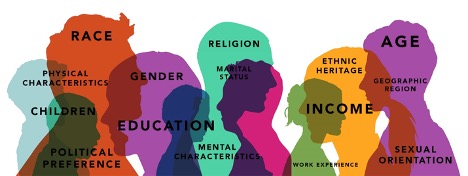
Social psychologists have developed several ways to measure this automatic preference, the most famous being the Implicit Association Test (IAT) which measures relatively automatic biases that favour own group relative to other groups (IAT; Greenwald, Banaji, Rudman, Farnham, Nosek, & Mellott, 2002; Greenwald, McGhee, & Schwartz, 1998). The test itself is rather simple (and you can experience it yourself here). The IAT is an especially useful way to measure potential biases because it does not simply ask people to openly report on the extent to which they discriminate against others. Instead, it measures how quickly people make judgments about the goodness or badness of various groups. The IAT is sensitive to very slight hesitations that result from having automatic or unconscious biases.
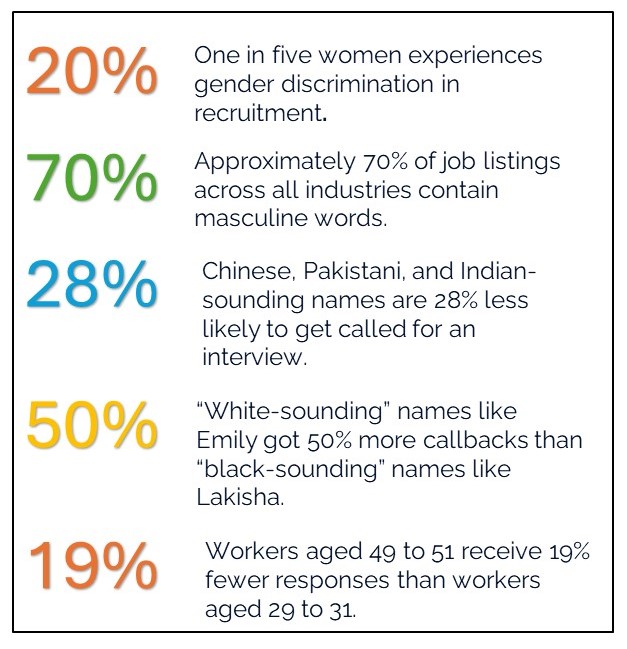
People are generally faster at pairing their own group with “good” categories. In fact, this finding generally holds regardless of whether one’s group is measured according to race, age, religion, nationality, and even temporary, insignificant memberships.
It turns out, that people’s reaction time on the IAT predicts actual feelings about out-group members, decisions about them, and behaviour toward them, especially nonverbal behaviour (Greenwald, Poehlman, Uhlmann, & Banaji, 2009). For example, a job interviewer might have two qualified applicants; a man and a woman. Although the interviewer may not be “blatantly biased,” their “automatic or unconscious biases” may be harmful to one of the applicants. For example, the interviewer might hold a negative view of women and, without even realizing it, act distant and withdrawn while interviewing the female candidate. This sends subtle cues to the applicant that she is not being taken seriously, is not a good fit for the job, or is not likely to get hired. These small interactions can have devastating effects on the hopeful interviewee’s ability to perform well (Word, Zanna, & Cooper, 1974).
Although this is unfair, sometimes the unconscious associations—often driven by society’s stereotypes—trump our own explicit values (Devine, 1989). Sadly, this can result in consequential discrimination, such as allocating fewer resources to disliked outgroups (Rudman & Ashmore, 2009).
Ally or Allyship
Merriam-Webster defines “ally” as “one that is associated with another as a helper; a person or group that provides assistance and support in an ongoing effort, activity or struggle” (TCU, 2022, para 1). In recent years, the term has been adopted specifically to a person supporting a marginalized group. In this respect, being an ally means disrupting oppressive spaces and places. It is understanding the struggle of oppressed and marginalized people and how that oppression operates in order to end it through action. For someone in a dominant group, being an ally requires self-reflection on their own privilege as well as accepting their role in oppression.
Being or becoming an ally is a process rather than a destination; the process requires continual learning and self-awareness. Being an ally requires action: telling colleagues that their jokes are inappropriate; advocating for the health, wellness and acceptance of people from underrepresented or marginalized groups. Ultimately, an ally is someone who is willing to use their privilege as a member of a dominant group and the power that comes with that privilege to advocate and work on behalf of the interests of marginalized and oppressed groups.
Privilege
The Oxford Language dictionary defines privilege as “a special right, advantage, or immunity granted or available only to a particular person or group”. In the context of EDI, “privilege refers to the social, economic and political advantages or rights held by people from dominant groups on the basis of gender, race, sexual orientation, social class, etc. [Privilege is] unearned social power (set of advantages, entitlements, and benefits) accorded by the formal and informal institutions of society to the members of a dominant group (e.g., white/Caucasian people with respect to people of colour, men with respect to women, heterosexuals with respect to homosexuals, adults with respect to children, and rich people with respect to poor people)” (EDI Glossary, n.d.).
Privilege is often difficult to recognize for members of dominant groups because while many are willing to admit that those in marginalized groups live with a set of disadvantages, very few are willing to acknowledge the benefits they receive from being a member of the dominant group. “In other words, men are less likely to notice/acknowledge a difference in advantage because they do not live the life of a woman; white people are less likely to notice/acknowledge racism because they do not live the life of a person of colour; straight people are less likely to notice/acknowledge heterosexism because they do not live the life of a gay/lesbian/bisexual person” (EDI Glossary, n.d.). The following TedTalk video, Understanding My Privilege, explores the benefits of recognizing and unpacking privilege.
Decolonization
Colonization is not an event. It is a structure. It is not something that happened in the past. Colonization is a complex system that is currently working to negatively impact each and every one of us. Colonization has led to the environmental destruction of the land, the attack on human lives, and the economic inequities experienced predominately by racialized people. It has caused, enforced, and protected acts of slavery and genocide. It is a local phenomenon and a global phenomenon. Colonization can be found on street names that honour white colonizers, in textbooks that wipe out Indigenous history, and in the dominating European powers that have planted themselves around the world. To deconstruct colonization, we must collectively engage in a process of decolonization.
Decolonization requires a dismantling of power imbalances that uphold white superiority and dominance “and a shifting of power towards political, economic, educational, and cultural independence and power that originate from a colonized nation[‘s] own indigenous culture” (EDI Glossary, n.d.). Decolonization involves the dismantling of the social, political, and institutional structures that perpetuate systems deeming one group superior to another. Review the follow video, Decolonial Thinking, for a further explanation of what decolonization means.
Conclusion
Transformative learning takes place at the highest levels and occurs when we encounter situations that challenge our accumulated knowledge and our ability to accommodate that knowledge. Thus, developing communication competence in the area of equity, diversity, and inclusion will entail a degree of discomfort as we challenge our accumulated knowledge. Some of the skills important to developing this communication competence are the ability to empathize, accumulate cultural information, listen, resolve conflict, manage anxiety (Bennett, 2009) and to use the correct terminology to communicate our thoughts. You are already developing a foundation for these skills by reading this unit. In our next chapter, we examine EDI in the Canadian Workforce.
Attribution
This page has been edited and remixed from the following sources. Supplemental information has been provided by Tricia Hylton.
“Intercultural Communication” (2020) by Shannon Ahrndt is licensed under a Creative Commons Attribution-NonCommercial-ShareAlike 4.0 International License.
“Prejudice, Discrimination, and Stereotyping” by Susan T. Fiske is licensed under a Creative Commons Attribution-NonCommercial-ShareAlike 4.0 International License.
“Skoden” Copyright © 2022 by Seneca College is licensed under a Creative Commons Attribution-NonCommercial-ShareAlike 4.0 International License, except where otherwise noted.
References
Allen, B. J. (2011). Difference matters: Communicating social identity (2nd ed.). Waveland. Choice Programs. (2021). What is structural racism [Video]. Youtube. https://www.youtube.com/watch?v=rGY1EXgYD9g
Collier, M. J. (1996). Communication competence problematics in ethnic friendships. Communication Monographs, 63(4), 314–336. https://doi.org/10.1080/03637759609376397
CGSMUS. (2023). Decolonial thinking [Video]. Youtube. https://www.youtube.com/watch?v=6Km_TmRuk7Q
Gory, R. (2019). The evolving terms of sexuality and romantic attraction. Dictionary.com. https://www.dictionary.com/e/sexual-and-romantic-orientation/
Equinet. (2020). The other pandemic: Systemic racism and its consequences. Standard for equality bodies. https://www.youtube.com/watch?v=rGY1EXgYD9g
iHasco. (2021). What do equality, diversity, equity and inclusion mean? [Video]. Youtube. https://www.youtube.com/watch?v=St4hkzk1rdw.
Homophobia. (2020, February 20). Wikipedia. https://en.wikipedia. org/w/index.php?title=Homophobia&oldid=941774160
Mrkonjic, E. (2022). 21 eye-opening blind hiring statistics. GoRemotely. https://goremotely.net/blog/blind-hiring-statistics/
Ministry of Justice. (2023). Accessible Canada Act. Government of Canada. https://lawslois.justice.gc.ca/PDF/A-0.6.pdf
Nadal, K. (2014). A guide to responding to microaggression. Cuny Forum, 2(1), 71 – 76. https://ncwwi-dms.org/resourcemenu/resource-library/inclusivity-racial-equity/cultural-responsiveness/1532-a-guide-to-responding-to-microaggressions/file#:~:text=Kevin%20L.,toward%20oppressed%20or%20targeted%20groups.%E2%80%9D.
Oxford Languages. (n.d.). The oxford English dictionary. https://languages.oup.com/research/oxford-english-dictionary/
Statistics Canada. (2022). Racialized groups [Image]. Canada at a glance, 2022. https://www150.statcan.gc.ca/n1/pub/12-581-x/2022001/sec3-eng.htm
Statistics Canada. (2023). New data on disability in Canada. [infographic]. https://www150.statcan.gc.ca/n1/pub/11-627-m/11-627-m2023063-eng.htm
Tatum, B. D. (2000). The complexity of identity: “Who am I?” In M. Adams, W. J. Blumfeld, R. Casteneda, H. W. Hackman, M. L. Peters, & X. Zuniga (Eds.), Readings for diversity and social justice (p. 9). Routledge.
TCU. (2022). Pride month: What does it mean to be an ally? News. https://www.tcu.edu/news/2022/what-does-it-mean-to-be-an-ally.php#:~:text=Merriam%2DWebster%20defines%20%E2%80%9Cally%E2%80%9D,person%20supporting%20a%20marginalized%20group.
Tedx Talks. (2017). Understanding my privilege [Video]. Youtube. https://www.youtube.com/watch?v=XlRxqC0Sze4.
The Other Box: Diversity, Equity, and Inclusion. (2023). What is the definition of microaggression. [Video]. Youtube. https://www.youtube.com/watch?v=19Lk9O6vMCM
Tucker, G. (2021). Measure implicit bias in your organization and eliminate it now. HRProfessional magazine. https://hrprofessionalsmagazine.com/2020/12/31/measure-implicit-bias-in-your-organization-and-eliminate-it-now/
University of British Columbia. (n.d.). EDI concepts and definitions. EDI glossary. https://vpfo.ubc.ca/edi/edi-resources/edi-glossary/#p
Wood, J. T. (2005). Gendered lives: Communication, gender, and culture (5th ed., p. 19). Thomas Wadsworth.
Yep, G. A. (2002). My three cultures: Navigating the multicultural identity landscape. In J. N. Martin, L. A. Flores, & T. K. Nakayama (Eds.), Intercultural communication: Experiences and contexts (p. 61). McGraw-Hill.
The ability to understand oneself and one's emotions.

